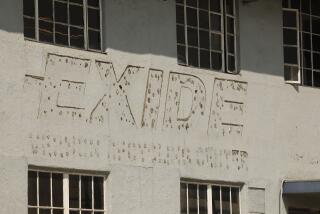U.S.-South Korean team investigates claim of buried Agent Orange
- Share via
Reporting from Seoul — Using such modern tools as ground-penetrating radar and conducting analyses of water and soil core samples, a team of investigators in South Korea is searching for clues to a decades-old mystery:
Did American soldiers dispose of the defoliant Agent Orange at a U.S.-run base about 150 miles southeast of Seoul in 1978?
For weeks, a U.S.-South Korean survey team has focused on a helipad site at the Camp Carroll base. Recently, tiny amounts of a toxic element found in Agent Orange were discovered in three nearby streams.
But South Korean officials say the amount of dioxin is too small to cause health problems such as cancer or birth defects and has not yet been connected to the alleged burial of drums containing Agent Orange at the base. U.S. officials say they have no evidence or records of Agent Orange ever being kept at the base.
The investigation was launched after a U.S. veteran told a Phoenix television station in May that he and others buried dozens of drums containing Agent Orange at Camp Carroll more than three decades ago.
“We’re taking the claim very seriously,” said U.S. Army Col. Joseph F. Birchmeier, an engineer and co-chairman of the joint investigative team. “Our focus is on the health and safety of U.S. soldiers and their families at Camp Carroll and of residents around the base.”
Radar mapping at Camp Carroll has detected objects that critics believe may be metal barrels, but U.S. officials say the anomalies could just be differing soil densities. Task force members have yet to decide whether to fully excavate the area.
If significant amounts of the herbicide are discovered, experts say, that could profoundly affect U.S. relations with one of its closest Asian allies, damaging U.S claims of being good stewards at scores of bases, many of which they have occupied since the end of the Korean War in the 1950s.
Some observers say the presence of Agent Orange could also fuel a sense among some South Koreans that the 28,500 U.S. troops in the country have worn out their welcome and should begin to withdraw. Many believe the chemical search should be widened to military bases nationwide.
South Korean lawmakers say they have not been given access to documents. Many say they fear the administration of President Lee Myung-bak, which supports a U.S. military presence, might cover up any negative investigation results determining environmental damage.
“The U.S. military is not opening its reports to the public,” said lawmaker Hong Hee-deok, a critic of the investigation. “Koreans are threatened by this, but we have limited access to information and this is frustrating.”
During the Vietnam War, the U.S. military sprayed millions of gallons of Agent Orange to kill jungle undergrowth that hid enemy fighters. Many U.S. veterans say they have suffered health effects from exposure to the compound.
Activists in South Korea say studies are just now being launched among residents near U.S. bases to determine what health problems exist, if any.
“We believe this goes beyond burial at one camp and that these chemicals are all over the country,” said Dae-Han Song, international liaison for a coalition of South Korean business and political interests called the National Task Force for the Investigation and Resolution of Agent Orange Burial by the U.S. Military.
Ted Barker, a former U.S. Marine who runs a website called the Korean War Project, said numerous servicemen have posted comments that they recall burying Agent Orange in South Korea.
“The U.S. military has a terrible record of burying chemicals,” said Barker, who did not serve in South Korea. “You’ve got something you need to get rid of, you just dig a hole. It’s the easiest way to make it go away.”
U.S. military officials acknowledge that barrels containing numerous chemicals were buried at Camp Carroll, but they say they were removed a year later. Records show Agent Orange was not among the compounds, they say.
“We’ve been upfront about this,” Birchmeier said. “Chemicals were buried there in the late 1970s, but the leadership soon realized this was probably not the right thing to do, so those same barrels were removed. The issue we’re having right now is that we haven’t been able to get definitive paperwork showing where those barrels were transported.”
The investigation is also looking into the spraying of Agent Orange in the late 1960s by South Korean troops along the demilitarized zone that separates North Korea and South Korea.
“We don’t know who brought it in and what route the chemicals took once they entered the country,” said U.S. Army Col. Jeffrey Buczkowski, a member of the joint task force. “The investigation is looking into the paper trail. We’re doing our best, combing through thousands of records to figure this out.”
Jung-yoon Choi of The Times’ Seoul bureau contributed to this report.
More to Read
Sign up for Essential California
The most important California stories and recommendations in your inbox every morning.
You may occasionally receive promotional content from the Los Angeles Times.











